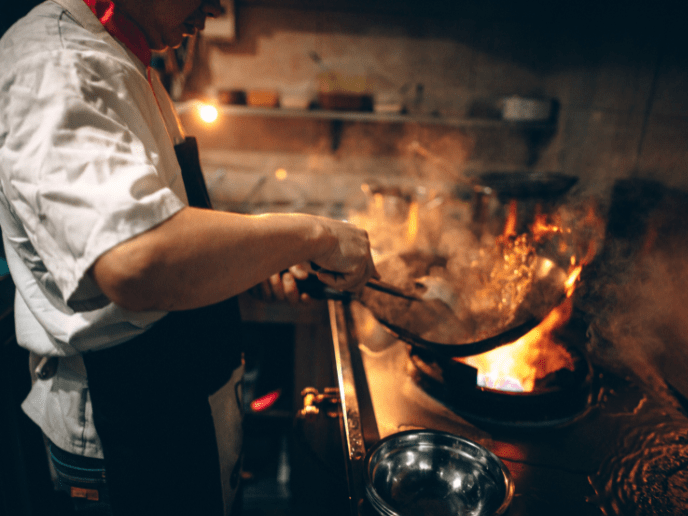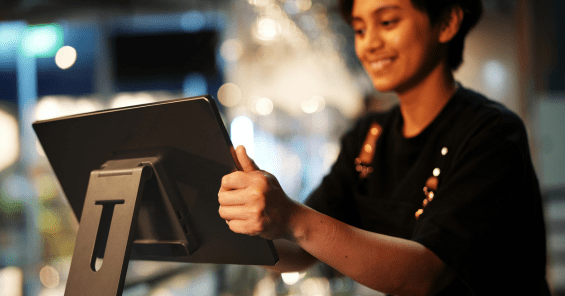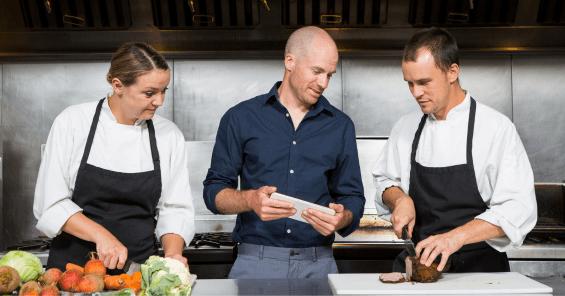

Die 5 wichtigsten Fragen zum Restaurantmanagement beantwortet
Entschlüsseln Sie die Geheimnisse eines hervorragenden Restaurantmanagements, ganz gleich, ob Sie ein neues Unternehmen gründen oder einen bestehenden Betrieb optimieren wollen. Dieser umfassende Leitfaden beantwortet häufig gestellte Fragen und geht auf wichtige Aspekte wie Kundenservice, Personalschulung und die bahnbrechenden Auswirkungen von Restaurantmanagement-Software ein.
Ganz gleich, ob sich Ihr Restaurant auf die große Eröffnungsfeier vorbereitet oder sein 10-jähriges Bestehen feiert, es ist nie ein schlechter Zeitpunkt, um mit der Einführung der besten Restaurantmanagementpraktiken und der Verbesserung Ihrer Prozesse zu beginnen. Oftmals verfügen Restaurantbesitzer, auch wenn sie die besten Absichten haben, über wenig oder gar keine Kenntnisse im Bereich Restaurantmanagement. Selbst erfahrene Restaurantbesitzer sind mit den vielen Aspekten des Restaurantmanagements überfordert und unsicher.
Sechs Gesetze für ein widerstandsfähiges Restaurant
Erfahren Sie, wie Sie jede Facette Ihres Unternehmens optimieren können, von der Optimierung der Speisekarte bis hin zu technischen Lösungen, und gewinnen Sie umsetzbare Erkenntnisse, wie Sie Geld sparen, das Engagement steigern und die Sicherheit in Ihrem Restaurant gewährleisten können.

Das Restaurantmanagement umfasst eine Vielzahl von Elementen, darunter:
- Kundenbetreuung
- Personalverwaltung
- Marketing
- Buchhaltung
- Kosten- und Bestandsmanagement
- Verfolgen Sie Ihren Cashflow
- Ausweitung der Verkäufe
- Senkung Ihrer Kosten und vieles mehr.
It is quite a task to take on for one, sometimes even two people and can be simplified if the right strategies are put in place for your restaurant’s needs.
With the development of new technologies and solutions to help ease and speed up processes, restaurant owners, at all levels of experience, can apply new and innovative methods to ensure they are maximizing their restaurant’s success.
With so many changes and newer options, there are many questions restaurant owners frequently ask in their efforts to improve, and sometimes save, their business. These FAQs prove the restaurant owners’ need for crucial answers to help even the basic of restaurant management tasks, because when dealing with such a long “to do” list, any bit helps.
Question 1: What is restaurant management software?
With constant digital advancements, more restaurants are investing in restaurant management software to help automate processes from billing, invoices and payment processing, to even table and menu management. In fact, according to Grand View Research, Inc., the restaurant management software market is said to reach $6.94 billion by 2024 with a significant annual growth rate of 14.6%.
Restaurant management systems not only allow you to increase the efficiency of your restaurant’s most pressing operations, it also provides a gateway for you to expand your business and sales by streamlining processes and reaching more people with features such as incoming payment processing, allowing your patrons to pay digitally.
As opposed to other retail management systems, these systems are specifically restaurant oriented to be able to track your inventory and finances in a way that best translates to your line of work.
Restaurant management systems help automate a multitude of processes including recipe and menu pricing, mobile orders and tip management, customer management and promotions, wastage reports, inventory management, accounting, sales, billing and so much more.
Without a restaurant management system many of these processes are done manually, if at all, and are subject to an abundance of costly errors. Further, a system that helps track and monitor your payments and shows you the big picture of your restaurant’s activity will help improve your customer service as well as your relationships with your vendors.
Question 2: How can I improve restaurant management?
Even those who read all the books and ask all the questions can never really be prepared for what restaurant management means. It takes time to learn how your restaurant will operate and how you operate within the business. That is not to say that you shouldn’t come prepared with a plan of action and get advice from others, as long as you are able to adapt and make changes along the way because what might have suited your friend who had a bar, might not be the same story for your restaurant.
Understand your management style
How do you want to communicate with your staff, your vendors and of course, your customers? Be consistent in how you handle rushes and slow periods of the day; it is usually best to set a foundation for an environment that does not get overly stressed and break under pressure.
Make sure everyone is trained
The competency of your staff is key to a smooth operation. Training your employees on customer service, inventory management, sales and all other operational procedures to standardize the way your restaurant runs is the best way to ensure you are well prepared for anything. Make sure to update your training procedures and your employees as things change within the restaurant.
Focus on your customer experience
In 2019, the restaurant industry comprised 51% of the US family dollar and over 45% of diners admit to eating out multiple times a week, meaning you’ve got quite a crowd to work with. Take word of mouth seriously and listen to what your customers are saying. Make sure you are providing them with an experience they will remember as a studies have shown that a large portion of restaurant goers are looking for more than just good food.
Adapt new solutions
The old days of bulky and disconnected systems are ending and more restaurants are shifting into the days of newly vamped restaurant management software available on the market. Updating your software might seem like a laborious operation however, nowadays software solutions boast simple integration, reducing the stress of new system training and adoption.
Question 3: How do I use restaurant management software?
Your restaurant management system should be able to seamlessly integrate with most existing POS and CRM systems you have in place. Management software designed with restaurants in mind offers features and components to help put all your restaurant’s activities in one place so that you can get a real time overview of your restaurant’s financial and operational health.
Once you have found the solution you feel can best support your restaurant’s needs, you should schedule a demo and be prepared to meet and ask any and all questions. Make sure you know your business well so that you can choose a system based on the best quality for the best price with regards to your volume of sales.
Today, the optimal choice is a cloud based system, which means simple integration so you can begin using your new system in minutes, as well as easy access from anywhere with wifi so that you are able to track your restaurant’s activity, in real time, even if you’re not there.
Your software solution will often times offer a simple link for download and require a few simple steps for set up. Your system should offer one, simple to use dashboard where you can take minimal time to learn and understand it, as well as customize it to look and flow however you need.
Question 4: How much does restaurant management software cost?
Firstly, in order to be sure and confident in your purchase and the investment you are about to make it would be best to begin with a free trial, which most companies offer, and if they don’t you might seriously want to reconsider locking yourself down to a solution you know very little about.
Prices will vary depending on multiple factors. An in-house or on-premise solution often requires bulky hardware and extensive installation and can reach several thousands of dollars in licensing fees and equipment, plus ongoing service and support fees. If you need installation at your bar, front end and kitchen for example, these costs add up.
Cloud based solutions are sometimes offered for free download and include in-program purchases as well as a monthly subscription fee. However, prices can be significantly lowered due to the ease of installation and lack of hardware needed for purchase, and usually range on an average of $59 - $300+ per station. Download your cloud based solution onto a tablet and you’re ready to go!
Question 5: What is the best restaurant inventory and management software?
The best restaurant inventory and management software should include all the necessary features mentioned, provide the most comprehensive and useful tools and require minimal effort in understanding the use, while remaining cost efficient for the restaurant owner.
Automating these processes can help your restaurant scale up as you are able to manage all your franchises in one place. This shift to automation is finally allowing restaurant owners to spend less time on the managerial tasks and more time on improving their customer experience.
MarketMan, ranked on a few lists as one of the top ten restaurant inventory and management solutions, focuses on helping restaurant owners achieve greater success. MarketMan gives you the tools you need to manage your inventory, suppliers, orders, and menu costing, get accurate food cost insights and, most importantly, know where your money is going in real time. With this cloud based solution you can set alerts when menu items become less profitable and get notifications when supplier prices fluctuate, giving you better control over your business.
MarketMan’s software works in any environment and allows you to access your information from you phone, computer or tablet, making sure you always stay connected. MarketMan’s solution is suitable for restaurants of all sizes and provides an agile and customizable platform for all your restaurant management needs.

MarketMan's restaurant management software gives you the power to automate inventory tasks, control food costs, and optimize back-of-house operations. It eliminates manual work and offers restaurateurs advanced insights for strategic decision-making. Boost your efficiency, reduce waste, and take the stress out of restaurant inventory management. Book a demo today to discover how MarketMan can transform your restaurant!
Autor
Contributors
Wenn Sie Fragen haben oder Hilfe benötigen, wenden Sie sich bitte an
Verpassen Sie es nicht, den Gewinn Ihres Restaurants zu maximieren! Berechnen Sie Ihren ROI mit MarketMan
Join over 18,000 restaurants and get the hottest restaurant tips delivered to your inbox
You may also be interested in
Sind Sie bereit, loszulegen?
Sprechen Sie noch heute mit einem Restaurantexperten und erfahren Sie, wie MarketMan Ihr Unternehmen unterstützen kann






